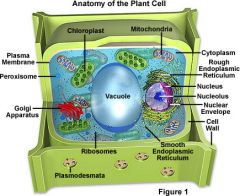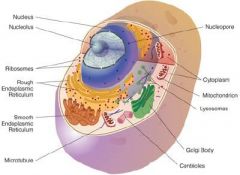![]()
![]()
![]()
Use LEFT and RIGHT arrow keys to navigate between flashcards;
Use UP and DOWN arrow keys to flip the card;
H to show hint;
A reads text to speech;
33 Cards in this Set
- Front
- Back
- 3rd side (hint)
|
organism
|
An organism is a living thing.
|
|
|
|
anaphase
|
Anaphase is the 4th stage of mitosis when the chromosomes are separated from each other.
|
|
|
|
cell
|
A cell is the smallest functional unit of all things.
|
|
|
|
metaphase
|
Metaphase is the 3rd stage of mitosis when the two copies of the chromosomes line up in the center of the parent cell.
|
|
|
|
mitochondria
|
The mitochondria are organelles found in the cytoplasm of a cell that helps the cell convert food into useable energy.
|
|
|
|
mitosis
|
Mitosis is the process of cell division in which a parent cell divides and produces two identical daughter cells, each with same number of chromosomes as the parent cell.
|
Mitosis has 5 phases or stages
|
|
|
nucleus
|
The nucleus is the control center of the cell and contains the genetic material.
|
The nucleus controls the rest of the cell and is like the brain of the cell.
|
|
|
Chromatin
|
Thin strands in the nucleus that directs the rest of the cell. The chromatin contain genetic material known as DNA.
|
|
|
|
cell membrane
|
The cell membrane is the barrier around the cell's cytoplasm. The cell membrane controls what substances come into and out of a cell
|
|
|
|
DNA
|
Deoxyribonucleic Acid
|
DNA makes chromosomes
|
|
|
chromosomes
|
Chromosomes are genetic structures that affect cell activity.
|
|
|
|
endoplasmic reticulum
|
Endoplasmic reticulum are pathways in the cytoplasm of the cell that help move materials through the cell.
|
|
|
|
ribosome
|
Ribosomes are organelles where protein synthesis happens. Ribosomes are found in the cytoplasm or in the endoplasmic reticulum.
|
|
|
|
golgi apparatus or golgi bodies
|
Golgi bodies help package products from the endoplasmic reticulum and distributes the packages around the cell or outside of the cell.
|
|
|
|
telephase
|
Telephase is the the final phase of mitosis where the parent cell splits into two new daughter cells.
|
|
|
|
prophase
|
Prophase is the 2nd stage of mitosis when chromosomes copies are held together so they form a "X"
|
|
|
|
interphase
|
Interphase is the 1st stage of mitosis before a cell divides. As a cell prepares to divide, each chromosome in the nucleus makes an exact copy of itself.
|
|
|
|
nuclear membrane
|
The nuclear membrane surrounds and protects the nucleus.
|
|
|
|
nucleolus
|
The nucleolus is found in the nucleus and is responsible for making ribosomes.
|
|
|
|
vacuoles
|
Vacuoles are fluid-filled structures that temporarily store different substances needed by the cell. Some vacuoles are specialized for storing waste products.
|
Animal cells often have many small vacuoles.
|
|
|
cell wall
|
The cell wall is the outer barrier that provides extra support for plant cells and give the cell shape.
Cell walls are made mostly of cellulose, a fiber that is the main component in wood and paper. |
Cell walls are only found in plant cells.
|
|
|
chloroplasts
|
Chloroplast are food making structures in plan cells. Chloroplast contain the green pigment chlorophyll.
|
Chloroplast is only found in plant cells.
|
|
|
chlorophyll
|
Chlorophyll captures the energy of sunlight and uses it to combine water and carbon dioxide to make glucose.
Glucose is simple sugar plants use as food. |
Chlorophyll is only found in plant cells.
This food making process is called photosynthesis. |
|
|
photosynthesis
|
Photosynthesis is the process that plants go through to make food.
|
|
|
|
plant cell
|

|
|
|
|
animal cell
|

|
|
|
|
unicellular
|
An organism made from one cell.
|
The cell of a single cell organism has structures to help the organism move, get food, reproduce and survive.
|
|
|
prokaryotic cells
|
Prokaryotic cells do not have cell membranes.
|
|
|
|
eukaryotic
|
Eukaryotic cells have a cell membrane.
|
Most organisms except for certain types of bacteria have cell membranes.
|
|
|
organelle
|
Organelles are structures in the cell that carry out specific functions.
|
|
|
|
cytoplasm
|
Cytoplasm is the gel-like fluid that fills much of the inside of the cell.
|
|
|
|
lysosomes
|
Lysosomes are small, round structures containing chemicals that break down certain materials in the cell.
|
|
|
|
Specialized cell that work together to perform a certain function.
|
tissues
|
|

